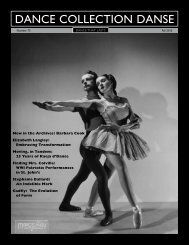DANCE COLLECTION DANSE
3E8Oe3fJp
3E8Oe3fJp
You also want an ePaper? Increase the reach of your titles
YUMPU automatically turns print PDFs into web optimized ePapers that Google loves.
Finding Mrs. Colville<br />
WWI Patriotic Performances<br />
in St. John’s<br />
BY AMY BOWRING<br />
Newfoundland has been the<br />
home of my maternal and<br />
paternal ancestors for over 200<br />
years. Its theatrical dance heritage<br />
has been a fascination of mine,<br />
and various research trips over the<br />
years have revealed the early echoes<br />
of theatrical dance in St. John’s in<br />
the twentieth century, as well as<br />
the later achievements of those<br />
who followed. It is a dance story<br />
that both reflects other patterns in<br />
Canadian dance history and that<br />
also etches its own distinct path.<br />
July 1, 2016 is an important date<br />
for the people of Newfoundland.<br />
It marks the 100th anniversary of<br />
the start of the Battle of the Somme.<br />
There, on that first day of July in 1916,<br />
at 9:15 a.m., 778 men of the Newfoundland<br />
Regiment went over the<br />
tops of their trenches near the French<br />
village of Beaumont-Hamel to attack<br />
the Germans. When the next roll<br />
Mr. Leonard Reid, Miss Mary Doyle, Miss Bartlett, Miss Lois<br />
Reid, Mrs. Helen Colville and Miss Flora Clift (sitting down)<br />
in Mrs. Colville’s Triumph of Harlequin, 1915<br />
call was taken, 68 men answered<br />
their names – 386 were wounded;<br />
324 were dead or missing and<br />
presumed dead. It was a defining<br />
moment for this small country. Even<br />
after Confederation with Canada<br />
in 1949, July 1 for Newfoundlanders<br />
has never been so much Canada<br />
Day as it is Memorial Day. Knowing<br />
the significant military sacrifices<br />
made by Newfoundland during the<br />
Great War, and knowing the prominence<br />
of patriotic performances<br />
to raise funds for the war effort in<br />
other parts of Canada, I became<br />
curious to know what Newfoundlanders,<br />
and specifically women<br />
in St. John’s, were doing in terms<br />
of performances for benevolent<br />
purposes during World War I. And<br />
that’s when I found Mrs. Colville …<br />
In the Dance Collection Danse<br />
archives, there are photocopies of a<br />
handful of pages from a 1916 publication<br />
called The<br />
Distaff produced by<br />
the Women’s Patriotic<br />
Association of Newfoundland.<br />
An article<br />
about amateur theatricals<br />
includes two<br />
references to a Mrs.<br />
Colville and includes<br />
two photographs of<br />
her productions: The<br />
Triumph of Harlequin<br />
and a pastoral play<br />
held at Vigornia,<br />
Cover page of the 1916 edition of The<br />
Distaff published by the Women’s Patriotic<br />
Association<br />
which was the estate of St. John’s<br />
bakery owner John Browning. With<br />
the help of archivists and digital<br />
sources at the Centre for Newfoundland<br />
Studies at Memorial University,<br />
Mrs. Colville’s contribution, and<br />
that of others, began to unfold.<br />
Born Helen Withers in the early<br />
1890s, Mrs. Colville was the daughter<br />
of John and Emma Withers;<br />
Withers had become the King’s<br />
Printer in St. John’s in 1890, replacing<br />
his own father in this role. As a<br />
member of the Church of England,<br />
young Miss Withers would have<br />
been educated at Bishop Spencer<br />
College in Newfoundland’s<br />
church-run school system. By the<br />
late 1890s, Bishop Spencer College<br />
had a reputation for offering<br />
a wide variety of extra-curricular<br />
activities including dramatics.<br />
24 Dance Collection Danse




